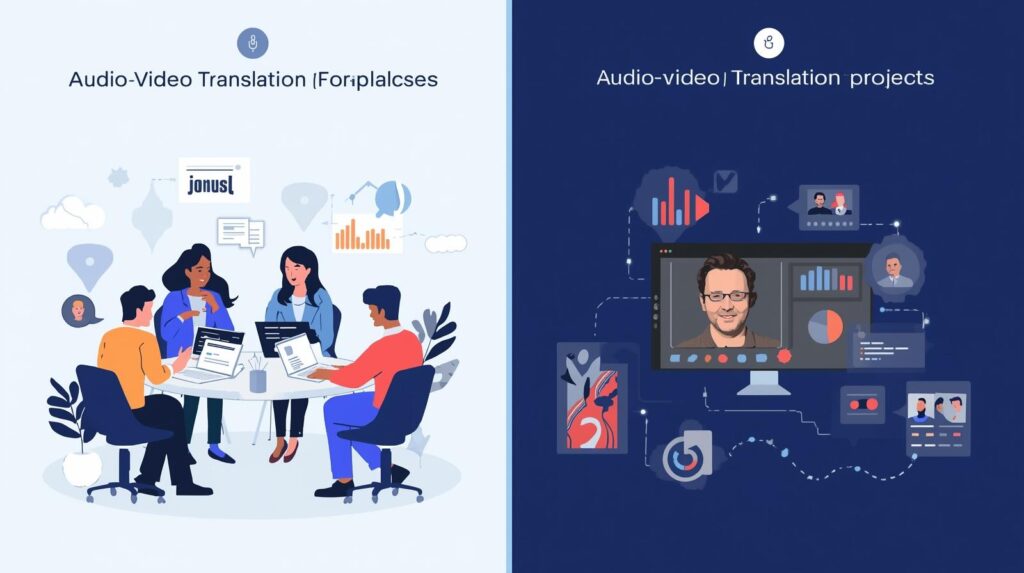Have you ever watched a foreign movie where the subtitles didn’t quite match the emotion or didn’t make sense at all? That’s the exact same feeling people can have about your project, too, if it’s poorly translated. Yes, that’s how significant the role of translation now is. A good translation can make a message feel natural and engaging, but a bad one can make even the best content confusing or awkward.
We live in a world where audio and video content have taken over the internet. Online videos, corporate training materials, college assignments, you name it. Multimedia has become a preferred way to communicate. And here in Australia, which is a highly diverse country, audio-video translation has become a must for businesses, educational institutions, and media production. A sloppy translation can easily distort your message, confuse your audience, or even hurt your brand reputation.
So, how do you make sure your project hits the mark? Let’s take a look at some of the best practices for high-quality audio-video translation.
Top Practices for Audio-Video Translation Projects

Here are the audio-video translation practices you should adopt:
1. Begin with Clear Goals and a Defined Audience
Before jumping into the translation process, take a moment to get your foundations right. Ask yourself these questions:
- “Who is my target audience?”
- “What language(s) do they speak?”
- “What’s the purpose of my video?”
A video made for a multilingual workplace training session will have a very different tone and vocabulary compared to a lifestyle YouTube video targeting viewers in Southeast Asia.
Setting clear objectives helps your translation team (and your budget) stay on track. It also ensures that translators can adapt tone, cultural references, and local idioms to suit the intended audience.
2. Choose the Right Type of Translation
Audio-video translation isn’t a one-size-fits-all service. There are several types, and choosing the right one depends on your project’s goals and format:
- Subtitling: Adding translated text at the bottom of the video. It’s cost-effective and great for social media, online courses, or international viewers who understand some English.
- Voice-Over: The original audio is lowered, and a translated voice is layered over it. Ideal for documentaries, explainer videos, or interviews.
- Dubbing: The original audio is replaced completely by a translated version, synced with lip movements. This approach works best for films, dramas, or high-end corporate productions.
- Transcription and Translation: The speech is first transcribed into text, then translated, which is useful for podcasts, interviews, and accessibility.
3. Use Native Linguists for Authenticity
It’s tempting to rely on AI tools for quick results, but human touch is irreplaceable in audio-video translation. Subtle changes in tone, phrasing, or cultural context can completely alter meaning.
That’s why you should always work with native-speaking translators and voice artists who understand the nuances of both the source and target languages.
For instance, Australian English has its own flavour. Words “arvo” (afternoon) or “heaps” (a lot) don’t always translate cleanly. A professional linguist knows when to keep the Aussie charm and when to adapt for clarity in another culture.
Beyond Translation, a trusted Australian language service provider, ensures that every project is handled by qualified linguists who are native speakers. Our team understands both the local Australian context and global communication standards, giving your content that perfect balance.
4. Keep Cultural Sensitivity in Mind
A literal translation might be technically correct, but still come across as awkward or even offensive in another culture. This is where cultural adaptation, or localisation, plays a key role.
For example, humour, gestures, and references that make sense in Australia might not land the same way in Japan or the Middle East. Even simple visuals like food, clothing, or slang can carry different connotations.
Cultural sensitivity is especially vital for marketing videos, brand campaigns, or educational content intended for international students. Partnering with a culturally aware team, such as Beyond Translation, ensures your message is not only understood but appreciated.
5. Focus on Technical Accuracy
Good translation isn’t just about words but also about timing, sound quality, and sync. For subtitling, each line must match the audio pacing and stay on screen long enough to be read. Voice-over and dubbing need precise lip-syncing and balanced sound levels.
Make sure your translation partner uses professional tools for:
- Time-coding (aligning translation with the original audio)
- Audio mixing and mastering
- Quality assurance (QA) checks before delivery
This technical attention to detail ensures that your final video looks and sounds professional, whether you’re presenting it at a corporate event or streaming it online.
6. Prepare a High-Quality Source File
Your translation is only as good as the source material. If the original video has poor sound quality, background noise, or unclear speech, it’s much harder to produce accurate translations.
Before sending your files to the translator, make sure:
- Audio is crisp and clear
- Speaker accents are easy to understand
- Background music doesn’t overpower voices
- Script (if available) is included
This preparation can save hours of editing later and improve the accuracy of transcription and translation.
7. Communicate Clearly with Your Translation Team
Think of your translation provider as a partner, not just a service vendor. Share as many details and as much context as possible, including:
- Who’s the intended audience?
- Should the tone be formal or conversational?
- Are there terms or names that must remain untranslated?
Good communication helps avoid rework and ensures the final output aligns perfectly with your goals. A company like Beyond Translation excels at this collaborative approach. We take the time to understand your project, offer suggestions, and deliver tailor-made solutions that fit your brand.
8. Be Accessible and Inclusive
Australia’s business and media landscape is diverse and inclusive, so accessibility should be part of every translation plan. Adding captions, subtitles, or descriptive audio not only supports non-native speakers but also benefits those with hearing or visual impairments.
It’s also worth noting that inclusive content broadens your reach, which makes your brand or message more accessible to all Australians, no matter their background.
Final Thoughts

Video is now dominating communication. This is why accurate and culturally sensitive translation can make or break your project. It’s not just about converting words but also about conveying meaning, emotion, and intent across languages and cultures.
If you’re ready to make your next audio-video translation project a success, our team at Beyond Translation is there to make sure you tick all the boxes. Connect with us to learn more about our audio-video translation services.
And make sure to follow these practices, as they can help you confidently take your message beyond borders.